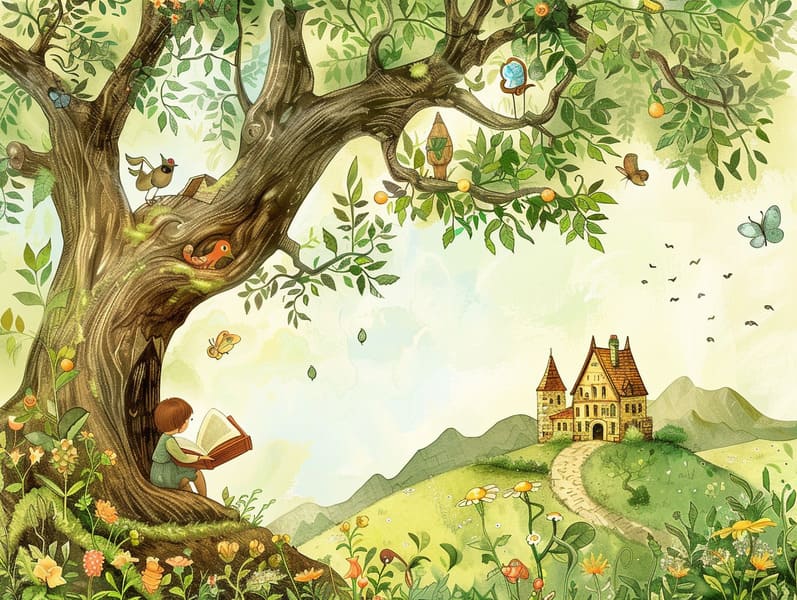
Timeless fairy tales have old origins. These narratives have been told from one generation to the next ages before they were ever published. They originated from a variety of backgrounds, including Middle Eastern traditions. They were initially told among adults, often carrying themes and messages pertaining to the societal norms and beliefs of the time.
The Grimm brothers, Jacob and Wilhelm Grimm, were among the first to assemble many of these beloved fairy tales. Their published works, "Grimm's Fairy Stories," included stories like "Cinderella," "The Story of Hansel and Gretel," and "Schneewittchen," which have since become mainstays in the world of timeless fairy tales. Similarly, H. C. Andersen's delightful tales, such as "The Mermaid," and "The Duckling's Story," have captivated hearts worldwide, cementing their place in the pantheon of famous fairy tales.
Even though they are old, these tales remain as meaningful as ever, especially as bedtime stories for kids. These enchanting tales are now available in many formats, including vibrantly illustrated books, fantastical animations, and online fairy tales.
Their continued relevance can be credited to several delightful features:
Important Morals: Ancient fairy tales often share important moral lessons. Stories like "The Wolf and the Liar" teach the value of truth, while "The Story of the Tortoise and the Hare" highlight the benefits of tenacity and unassuming nature. These tales offer the young clear distinctions between truth and falsehood, building their moral compass in a soft yet important way.
Empathy and Understanding: Fairy tales frequently depict characters facing trials and tribulations, encouraging young readers to feel with their struggles and applaud their triumphs. For instance, "Beauty and the Beast" highlights the necessity of seeing beyond looks to appreciate the inner spirit of a person, encouraging tenderness and appreciation.
Cultural Awareness: Many traditional fairy tales are deeply ingrained in the cultural contexts from which they blossomed. Discovering these narratives can provide delightful insights into different customs, nurturing a sense of global appreciation and recognition.
Fantasy and Imagination: The imaginative elements in timeless fairy tales—wizardry and magic—kindle children’s fantastical thinking. These tales carry readers to imaginary realms, enlivening creative ideas and a sense of excitement that persists a lifetime.
Classic fairy tales are not only captivating but also edifying. They act as enchanted tools in developing various cognitive and affective skills in children. When old fairy tales are narrated, they develop speaking abilities by showing new terms and meanings and elaborate sentence structures. This practice also nurtures hearing perception and attention span, as young ones listen intently, expectant to see what happens next.
Furthermore, discussing the themes and characters of timeless fairy tales can cultivate critical thinking and evaluative skills. Young readers are shown to detect patterns, guess what will happen, and get cause and effect. These talks also ease young readers speak out their thoughts and feelings, enhancing their emotional intelligence.
In today’s modern era, the availability of internet fairy tales has made these stories more obtainable than ever. Web platforms and programs share vast collections of old fairy tales that can be enjoyed or listened via anytime, anywhere. Fairy tales told out loud are particularly popular, making available an engaging way for little ones to take part in these spellbinding stories. Read-aloud books and read-aloud videos bring characters and settings to life, often augmented by spellbinding musical scores and harmonies that raise the tale awesome site experience.
The lasting appeal of ancient fairy tales lies in their ability to evolve to today's world while retaining their central values. Contemporary adaptations of these narratives often highlight more different protagonists and modern settings, making them accessible to today’s audience. However, the main ideas of bravery, compassion, and lawfulness remain unchanged, continuing to move young listeners of all ages.
Old fairy tales also offer a sense of assurance and comprehensibility. They furnish a ordered narrative with a clear beginning, middle, and end, often finishing with the solving of conflicts and the triumph of good over bad. This predictability can be soothing for the young, sharing a sense of dependability in an inconstant world.
Classic fairy tales continue to charm and enlighten new generations, maintaining their charm and significance in modern society. As nighttime stories for kids, they confer upon a perfect blend of delight and instruction, developing moral values, empathy, and creativity. The existence of web-based fairy tales and the well-liked nature of fairy tales read aloud promise that these old fairy tales remain obtainable to new generations.
By guarding and narrating these fairy tales, we continue to acknowledge the rich tapestry of mythology and cultural heritage. Whether you are experiencing a gorgeously illustrated book, accessing a virtual library, or playing an spoken story, the charm of ancient fairy tales is always within reach. These tales remind us of the ageless power of fairy tales and its ability to bind us across eras and regions.
If you are exploring a artistically illustrated book, exploring a internet collection, or listening through an narrated book, the enchantment of bedtime fairy tales is always within reach.
These narratives demonstrate of the steadfast effect of tales and its ability to link us across eras and regions, forging a link that charms and informs alike.